
– 16th June 2016 –

Gospel Text: Luke 7:36-50 (Short form)
vs.36 One of the Pharisees invited Jesus to a meal. When he arrived at the Pharisee’s house and took his place at table,
vs.37 a woman came in, who had a bad name in the town. She had heard he was dining with the Pharisee and had brought with her an alabaster jar of ointment.
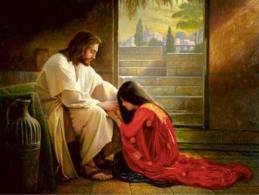 vs.38 She waited behind him at his feet, weeping, and her tears fell on
vs.38 She waited behind him at his feet, weeping, and her tears fell on
his feet, and she wiped them away with her hair; then she covered his
feet with kisses and anointed them with the ointment.
vs.39 When the Pharisee who had invited him saw this, he said to himself, “If this man were a prophet, he would know who this woman is that is touching him and what a bad name she has.”
vs.40 Then Jesus took him up and said, “Simon, I have something to say to you.”
“Speak, Master” was the reply.
vs.41 There was once a creditor who had two men in his debt; one owed him five hundred denarii, the other fifty.
vs.42 They were unable to pay, so he pardoned them both. Which of them will love him more?”
vs.43 “The one who was pardoned more, I suppose” answered Simon. Jesus said, “You are right.”
vs.44 Then he turned to the woman. “Simon,” he said “you see this woman? I came into your house, and you poured no water over my feet, but she has poured out her tears over my feet and wiped them away with her hair.
vs.45 You gave me no kiss, but she has been covering my feet with kisses ever since I came in.
vs.46 You did not anoint my head with oil, but she has anointed my feet with ointment.
vs.47 For this reason I tell you that her sins, her many sins, must have been forgiven her, or she would not have shown such great love. It is the man who is forgiven little who shows little love.”
vs.48 Then he said to her, “Your sins are forgiven.”
vs.49 Those who were with him at table began to say to themselves, “Who is this man, that he even forgives sins?”
vs.50 But he said to the woman, “Your faith has saved you; go in peace.”
*******************************************
We have four commentators available from whom you may wish to choose .
Michel DeVerteuil : A Trinidadian Holy Ghost Priest, director of the Centre of Biblical renewal .
Thomas O’Loughlin: Professor of Historical Theology, University of Wales, Lampeter.
Sean Goan: Studied scripture in Rome, Jerusalem and Chicago and teaches at Blackrock College and works with Le Chéile.
Donal Neary SJ: Editor of The Sacred Heart Messenger
*******************************************************
Michel de Verteuil
Lectio Divina, The Year of Luke
www.columba.ie
General Textual Comments
Once again, as in the last two Sundays, we see Jesus relating with people. This time the passage is much more complex.
First of all, there are really two stories:
– Jesus relates with the Pharisee in verses 39 to 47.
– Jesus relates with the woman in verses 36 to 38 and then again in verses 48 and 50.
St Luke evidently intended the two stories to shed light on each other, but they can also be taken separately.
In either story you can focus on Jesus, noting how he treats each of the two people differently, according to their needs, but being compassionate and respectful to both.
You can identify with the Pharisee, noting his good points as well as the bad ones, making sure you don’t read it self-righteously, but discovering yourself in him.
The woman symbolizes all outcasts, those who “have a bad name in town” for any reason whatsoever.
The parable in verse 41 can stand on its own and you may find that it touches you.
Verse 49 introduces a group of people “with Jesus at table”; you may find that you identify with them, or with the way Jesus relates with them in verse 50.
Scripture reflection
“Of all mankind’s needs, the most persistent, terrible and demanding is that which springs from the inescapable fact of sin and the need for forgiveness and redemption. This, first and last, is what priestly ministry is all about.” …Norman Goodall
Lord, it happened in the past that Church leaders put too much stress on sin,
so that people were overly burdened by feelings of guilt.
As a result, today priests have gone to the other extreme
and do not allow us to make the painful journey to repentance.
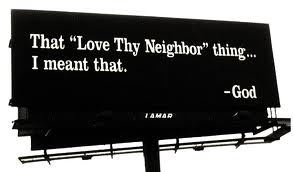 Teach them to be like Jesus, to remain silent and respectful
Teach them to be like Jesus, to remain silent and respectful
as we wait humbly in the background, weeping for our sins:
– sins of abortion;
– how we have maltreated members of our family;
– our jealousy of those who succeed where we have failed.
It is the only way we can know that our sins are forgiven,
that deeper than our sinfulness there is a faith which saves us
and that we can go in peace.
“Women are more linked than men to the soul of the world, to the primary, elemental forces. Masculine culture is too rational, too far from the immediate mysteries of cosmic life and it returns to it through women.” …Nicolas Berdyaev
Lord, we thank you for the woman in today’s gospel story,
and we thank you that Jesus defended her against the Pharisee.
We pray that our Church leaders may do the same for women in the world today.
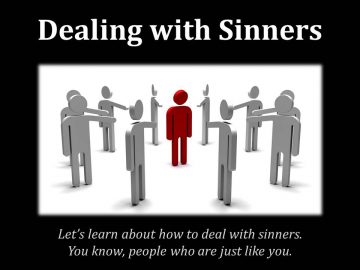 Lord, in the Church today we have a way of categorizing certain people as sinners.
Lord, in the Church today we have a way of categorizing certain people as sinners.
We treat them with condescension and speak of “praying for their conversion”.
But this is not the way of Jesus.
When people came to him who had a bad name in their communities
he welcomed them with respect, thanked them for their love,
proposed them as models for those who sat at table with him,
and assured them that it was their own faith that had saved them.
“No one is so poor that they cannot give,
and no one so rich that they cannot receive.” ..Helder Camara
Lord, give to your Church the wisdom of Jesus,
that like him we may speak the right word to every group –
to those who are complacent like the Pharisee, a word of challenge,
inviting them to discover their lack of humanity;
to those who are treated as outcasts, like the woman in this story,
a word of encouragement and of healing.
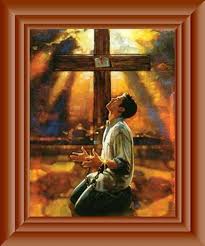 Lord, in life we receive countless lessons that leave us unmoved.
Lord, in life we receive countless lessons that leave us unmoved.
But every once in a way you send us someone like Jesus,
one of our parents or relatives, a teacher, a spiritual guide.
They walk with us in our search for the truth;
“I have something to say to you” they tell us,
and then they wait for us to ask them before they continue.
They tell us stories, and let us discover for ourselves
the lesson they want us to draw, assuring us then that we were right.
Thank you, Lord, for those teachers.
Lord, when we come to positions of authority in a community,
whether in the State or in the Church,
we soon become cold and business-like in our relationships with people.
We no longer welcome them warmly or show them signs of affection.
It is because we are complacent.
But you always seem to send us some Jesus
who reminds us of the many things people have had to pardon us
so that we could get where we now are.
Lord, there is within each one of us a sinful person
waiting in the shadows and needing to be recognized and accepted.
Do not let the Pharisee in us repress that part of ourselves
As if good people should not let themselves be touched by sin.
Lord, truly kind people have an extraordinary power.
We who live with them are constantly amazed
at how they can make others experience that their sins are forgiven.
Such people are the presence of Jesus with us.
*******************************************
Thomas O’Loughlin
Liturgical Resources for Year C (Luke)
www.columba.ie
Introduction to the Celebration
Today is one of the very few times in the year when the actions of women towards Jesus are at the centre of our recollection. We recall that Jesus was supported and helped by women in his work as he moved around Palestine. We also recall the incident when an unnamed woman anointed his feet with oil, kissed his feet, and wiped away her tears with her hair. Her sins were forgiven because she had shown such love.
Now we are gathered at table with the Lord, let us pray that our love will be such that our sins may be forgiven.
Gospel notes
Two completely separate pieces of his narrative are placed one after another simply because the first story concerns Jesus and a woman, so that forms the cue to Luke to inform us of the women in the support group around Jesus.
The woman forgiven her sins brings out several Lukan themes: Jesus accepting a welcome to sit at table, his rejection of the notion that God’s mercy is limited to the religiously observant and up-right, and that love is the centre of the law.  It also provided Luke with an opportunity to show Jesus as a prophet and as one who can on his own authority forgive sins. Luke is here assembling a snapshot of who Jesus is seen to be in this instance: the Anointed One (i.e. the Christ), the Prophet, the Forgiver, the Saviour.
It also provided Luke with an opportunity to show Jesus as a prophet and as one who can on his own authority forgive sins. Luke is here assembling a snapshot of who Jesus is seen to be in this instance: the Anointed One (i.e. the Christ), the Prophet, the Forgiver, the Saviour.
Traditionally, this woman who anoints his feet in this scene is identified with Mary Magdalen (hence ‘maudlin’ [using the Middle English pronunciation of ‘Magdalene’] for a crying woman, and ‘Magdalen Homes’ for ‘fallen women’). Not only is this identification (1) wholly unfounded; (2) a recollection of an attitude to women pursued in the name of the church that is a horrible blemish in our history; (3) but shows with what little care this gospel passage was read: it is essential to Luke’s message that this woman is without a name for she is representing all humanity before the Christ – and an individual name would distract from that role. So make sure you do not refer to this woman as ‘Mary Magdalen’.
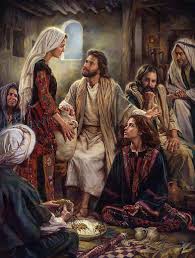 By contrast with the anonymous woman of the first part, there are three women named as being part of the entourage or support network of Jesus. The named women were obviously well remembered in the early church. However, Mary from Magdala apart, who is remembered as a pastiche of several women in the gospels, neither Joanna nor Susanna passed into hagiographic memory while the work done by women that is recalled here by Luke was almost wholly forgotten.
By contrast with the anonymous woman of the first part, there are three women named as being part of the entourage or support network of Jesus. The named women were obviously well remembered in the early church. However, Mary from Magdala apart, who is remembered as a pastiche of several women in the gospels, neither Joanna nor Susanna passed into hagiographic memory while the work done by women that is recalled here by Luke was almost wholly forgotten.
Homily Notes
1. How do you imagine Jesus moving around Palestine? It is usually an all male affair: Jesus in the lead, and twelve men following on behind. It is the same group that we think of around the table in the famous picture of the Last Supper by Leonardo da Vinci. Indeed, this is the way Jesus and his group have usually been painted: a group of twelve men around Jesus, and then that small group meet other people such as Pharisees, women, tax collectors, the crowds that came to listen, and then the occasional other named individual. Indeed, the group around Jesus is so small and so focused on the twelve that we call them in everyday speech, ‘The Twelve Disciples’ or ‘The Twelve Apostles’ or simply ‘The Apostles’ and mean by that name the twelve men that went about with Jesus.
2. When we read the gospels a little more carefully we see a much richer picture than that popular memory; and the end of today’s gospel is one of those few times when we publicly read at the Eucharist one of those little details that can so alter how we imagine Jesus and his first followers.
3. Let us begin with noting the diversity of the women mentioned today. There is this woman called Mary from Magdala (traditionally she has been amalgamated with other women named ‘Mary’ and with a few unnamed women also). She might be seen as a typical hanger on to a religious reformer as she has been cured by him. She is obviously travelling with Jesus, but there is no indication that she was one of those who could provide for the needs of the group. Then there are Joanna and Susanna who are clearly wealthy, and very independent minded women (e.g. we are told about Joanna, but not what Chuza thought about Jesus), who were also influential in society. Then we are told that there were many other women, and that these women provided ‘out of their own needs’ for what was needed to support the group, Jesus and his followers, who were making their way around Palestine ‘bringing the good news of the kingdom of God’ to the towns and villages. In modern jargon it is these women and their wealth and generosity – that are ‘the grass-roots support’ or ‘the logistic support infrastructure’ for the coming of the kingdom.
4. So how can we have a more adequate picture of Jesus with his first disciples? We could think of it as four concentric circles around Jesus. The largest group is made up of all those women and men – who listen to him and accept his message that the kingdom of God is coming close to them. Then in the next circle there are those – women and men — who are devoted to him. They provide the support structure that allows him and his followers to move about preaching. They must have provided support in many ways – shelter, food, hospitality, and also money. Many of the women mentioned in today’s gospel belong to this circle.
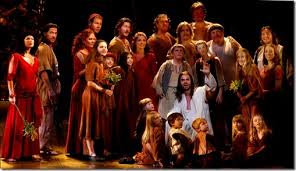
Then there is the circle made up of men and women who travelled around with Jesus. This group was not only his support team, but the community that encapsulated in its manner of living the new way of life that belongs to the New People of God. It is with this group we have to imagine Jesus sitting down each day at table and it is from this group that some were sent off preaching two by two. All the people – women and men – in the second and third circles are, as a group, named ‘the disciples’, while those from this group who were sent off on missionary tasks were called the’ apostles’. Lastly, we come to the small inner circle of twelve men known simply as ‘The Twelve’ This group was chosen by Jesus to be for the New People of God what the twelve sons of Jacob (i.e. the fathers of tribes) were for the original People of God.
5. So we have (1) Jesus and (2) his symbolic group of ‘Twelve,’ then (3) we have ‘The Disciples’ that went arour with him on his preaching mission: men and women who: number we do not know and only a couple of whose name we know, then (4) we have more ‘Disciples’ that enabled the preaching group to stay on the road; and then (5) those who accepted the news of the kingdom.
6. The whole picture – although it is far more complex how, a marvellous array of ways of being at the service of the gospel. And, without those women who were fully part of the ministry of Jesus, the good news would not have been proclaimed.
7. We use phrases like ‘the church founded on the apostles’ and ‘the apostolic church’ and we think of twelve men; when we use such phrases we must include Mary from Magdala, Joanna the wife of Chuza, Susanna, and the many other women mentioned by Luke.
****************************
3. Sean Goan
Let the reader understand
www.columba.ie
Gospel
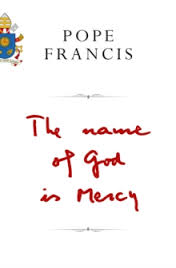 The themes of repentance and forgiveness that were addressed in the first reading are approached now from a different perspective, one that highlights how difficult it can be for some so-called virtuous people to really believe in the unconditional mercy of God for sinners. This theme is important in Luke’s gospel as is the role of women, and both are present in this section of the gospel.
The themes of repentance and forgiveness that were addressed in the first reading are approached now from a different perspective, one that highlights how difficult it can be for some so-called virtuous people to really believe in the unconditional mercy of God for sinners. This theme is important in Luke’s gospel as is the role of women, and both are present in this section of the gospel.
Meals are often a central focus for important words and actions of Jesus and we don’t have to wait for the last supper to realise this. In today’ story we are invited to contrast two different attitudes to Jesus. One is that of the Pharisee who invites Jesus to his house, the other is the attitude of the woman who truly welcomes him into her life. The parable that
 Jesus tells to the shocked Simon and his friends explains the difference between the attitudes, Simon’s sense of his own importance prevents him from responding properly to his guest; the unnamed woman, on the other hand, knows that this man has restored her dignity in a way that no other could and so her heart bursts with gratitude. This story is about ‘table-fellowship’; it is a vibrant reminder that in the kingdom all are invited to sit at God’s table but some fail to appreciate what a gift this really is.
Jesus tells to the shocked Simon and his friends explains the difference between the attitudes, Simon’s sense of his own importance prevents him from responding properly to his guest; the unnamed woman, on the other hand, knows that this man has restored her dignity in a way that no other could and so her heart bursts with gratitude. This story is about ‘table-fellowship’; it is a vibrant reminder that in the kingdom all are invited to sit at God’s table but some fail to appreciate what a gift this really is.
Interestingly the woman is often associated with Mary Magdalene but no connection is made between them. In the verses after the story Luke tells us that as Jesus went on his way preaching the kingdom there was an important group of women who accompanied him, all of whom had experienced his saving work. One of these is Mary Magdalene, However, she is not described as a sinner.
Reflection
Every time we gather for the Eucharist we are invited not simply to sit down at table with the Lord but also with one another. Today we are asked to consider whether we attend in the manner of Simon and his friends or the manner of the woman who loves much because she has been forgiven much. David, in the first reading, came to an awareness of the painful truth about himself and that was why he was able to repent. This is a journey we all have to make if we are really going to appreciate what the Eucharist is all about.
********************************************
4. Donal Neary S.J.
Gospel reflections
www.messenger.ie
Precious gift
Every meal that Jesus shared says something to us about the Eucharist and about Christian community. His ‘last supper’ was one of many suppers, all of which explains something of who he is and who we are.
At this meal, the one who should have been barred at the door became the principal guest. At Mass all are welcome -the saint and the sinner. The table of the Eucharist would be a circular table, with nobody at the top.

It was a meal of giving something precious of oneself. Her tears were external signs of her real and true self.
We give at Mass – the offertory is the giving of the bread and the wine. With them we give the gifts of the heart at Mass; the love of our lives is poured into the Mass.
And Jesus gives forgiveness and healing. She left the meal better than she came in, and so we too leave Mass better than we came in.
The Mass is one time of giving ourselves as best we can to love and to God. Much of our giving to God is indirect. What we give to others we are giving to God at Mass.
A bright light came into that room when the woman arrived. She brought humility – she knew her place – warmly welcomed by Jesus. The Eucharist is where we are all equal in dignity. Our biggest dignity is we are children of God – she knew that, Simon didn’t. She gave of herself, from the heart and God saw that and said things about her that have lasted forever – things he might say of each of us. He loved much; she loved much. And because we are much loved we can love much in return.
Lord may I love in life what you love.